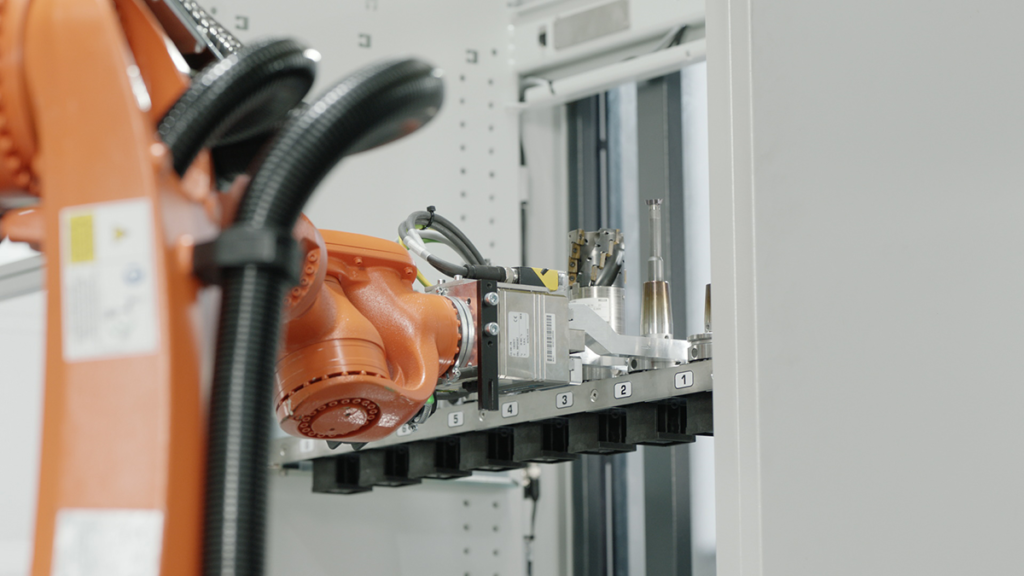From price increases to shortages of skilled labour, industrial companies are under increasing pressure to meet demands for quality, volume, and speed.
In a pilot project, KUKA and HELLER, a producer of CNC machine tools, have developed a solution to these challenges: A KMR CYBERTECH is now capable of automatically loading and unloading machines with tools which then provides relief to employees from undertaking repetitive tasks.
Tool automation is still in its early days
Low quantities, high complexity – and naturally everything as quickly as possible – is how Individual customer requirements pose real challenges for industrial companies. This is in addition to a shortage of skilled workers along with rising prices for energy, raw materials, and services. The solution? Enhanced automation. While automation solutions are already well advanced in such areas as palletising, handling or assembly tasks, tool automation – the flexible and automated loading and unloading of machines with tools – is still in its infancy. Together with KUKA, the globally active HELLER Group has launched and implemented a pilot project that aims to close this gap.
Strong partner
“There is a lot of potential in this area as it is not just about automating at the front end of the machine, but behind it as well,” says Robert Eber, who is responsible for pallet and robot automation at HELLER. The group manufactures CNC machine tools and production systems for machining at five production sites worldwide. Founded in Nürtingen, Germany in 1894, HELLER customers include numerous companies from the areas of general mechanical engineering, energy technology, fluid technology through to the aerospace and automotive industry including their suppliers HELLER had already used robot-based solutions from KUKA for other projects. However, the two companies have now worked together in partnership for the first time during this ground-breaking pilot project to develop a marketable solution in tool automation.
From customer inquiry to pilot project
The collaboration started with the aim of finding out which manual processes can be automated and where the limits lie. “The two companies established the requirement for a mobile robotic solution, and this then gave rise to the initial ideas, concepts and ultimately the implementation of the pilot project,” reports Steffen Günther, Global Business Development Manager at KUKA. Whilst the project was in place by the spring of 2021, it took a further year before one or two challenges were overcome, and the ideal solution, finally achieved.
KMR CYBERTECH takes on the job
Using information from the production order provided by employees, a host computer from CERTA determines which tools the machine needs. It orders the KUKA mobile robot KMR CYBERTECH to fetch the appropriate tools from the warehouse. The mobile platform, powered by omnidirectional technology and incorporating a KR CYBERTECH commences the selection process. “The KMR CYBERTECH was the optimal product for this since we have a maximum weight of up to 20 kilograms for the tool holder,” notes Günther. Its robotic arm grips the relevant tools and places them on the appropriate fixtures along the platform.
‘Shifting the focus of manual work’
The KMR CYBERTECH brings the parts to the appropriate machine tooling and places them where they are needed. “The automated solution eliminates the need for the employee to walk to the machine and insert the tools. This allows us to shift the focus of manual work,” explains Eber, with considerable savings both in time and costs. In this solution, the KMR CYBERTECH not only takes care of the loading and unloading, but also handles exchanges. For example, when the host computer receives information about a worn tool, the platform makes its way to the relevant machine. The tool is unloaded and taken away. A new tool is then picked and inserted into the machine.
Communication is what counts
During the development of this solution, the communication between all the systems involved was particularly challenging, as it was vital to establish, what data are available at what time and where? The most serious challenge facing us was the interfaces for data exchange,” says Eber. Thanks to the combined automation expertise of KUKA and HELLER, a suitable method was created, after a number of tests, in order to allow the mobile platform to do more than just move from A to B. The platform is now provided with the necessary information on an ad-hoc basis. This allows it to know exactly what needs to be done at any given time. A second requirement was also to be implemented during the pilot project. “We wanted to change as little of the manual operation as possible,” Eber specifies. “That is, employees should also still be able to insert tools and manage data, if at all necessary.”
The goal: Implement customer requests
The project has now been completed with synergy between the two companies and the operational feasibility, confirmed. The communication mode functions seamlessly and both humans and robots can now load the machines with tools. “We are now monitoring the market and are ready to move to the next level and by responding to customer requests,” confirms Eber. For KUKA, too, it was the first major project with mobile robotics in the field of tool automation. Günther is convinced that this will offset the shortage of skilled workers and strengthen the industrial companies’ capability to service customers with greater speed and efficiency. “Mobile robotics can perform this work 24/7, and skilled workers can focus on their own competencies as well as more value-added activities.” The foundation has been laid, and the cooperation with HELLER has already generated initial customer projects and offers. The task now is to integrate this forward-looking project into the production halls of existing customers and markets as well as new ones, globally. Certainly, for the electronics sector, cost savings alone would make implementing this process most advantageous.
There’s also plenty of other industrial editorial at IoT Insider’s sister publication, Electronic Specifier. And you can always add to the discussion at our comments section below or on our LinkedIn page here.
